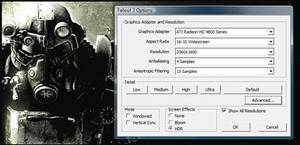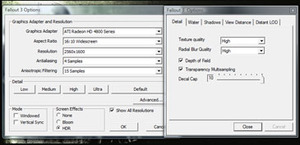Fallout 3
Publisher: BethesdaFallout 3 is the revival of Interplay’s excellent Fallout series of games following many years out of the limelight. It’s developed and published by Bethesda and, judging by the success of the game, we’ll be seeing more Fallout games in the future.
Despite using the Oblivion engine which is now a few years old, the game looks absolutely stunning. Bethesda has spiced up the graphics a bit since Oblivion and has extended the engine – there are some great explosions, soft shadows and smoke effects that are particularly noteworthy.
We tested the game by manually playing a section of the game that incorporates a number of explosions and effects that you’re likely to experience during your time in post-apocalyptic Washington DC. We recorded the frame rate using FRAPS.
The in-game details were set to their highest values and both anti-aliasing and anisotropic filtering were controlled by the application settings instead of through the driver control panel. This meant that transparency anti-aliasing was enabled, along with HDR and all of the cool smoke effects.
Fallout 3’s engine is by default capped to 60 frames per second, which can make benchmark results very unclear, especially when testing at lower resolutions or with high end graphics cards. To remove the 60FPS cap you’ll need to find the Fallout3.ini file in \Documents\My Games\Fallout3 and edit the file so that iPresentInterval=0. This removes the frame rate cap, and allows us to get a much better idea of a card’s abilities.
We were hoping for a better showing in Fallout 3 than in Crysis where the MSI GTX 285 HydroGen OC didn't perform a whole heap better than the stock GTX 285. Unfortunately we were met with a very similar set of results with the stock card lagging slightly behind in most tests and evening pipping the MSI GTX 285 HydroGen OC to the post at 1,680 x 1,050 4xAA 16xAF, Maximum Detail, although only by a tiny amount so it's likely to be within experimental error since this is a manual play test.
There was a noticeable difference at 2,560 x 1,600 though where at 0xAA 16xAF, Maximum Detail the MSI GTX 285 HydroGen OC managed a minimum frame rate of 39fps while the stock card could only muster 35fps. It was the same at 2,560 x 1,600 with 4xAA where the MSI GTX 285 HydroGen OC recorded a minimum frame rate of 32fps while the stock card lagged behind significantly at 27fps.
Compared to the extremely quiet Sapphire Radeon HD 4890 Atomic clocked at 1GHz, it's overall slower - and for the £100 difference in favour of the Sapphire you'd be hard pressed to recommend the MSI as an aftermarket solution, providing that is, you can actually find an Atomic for sale.

MSI MPG Velox 100R Chassis Review
October 14 2021 | 15:04











Want to comment? Please log in.